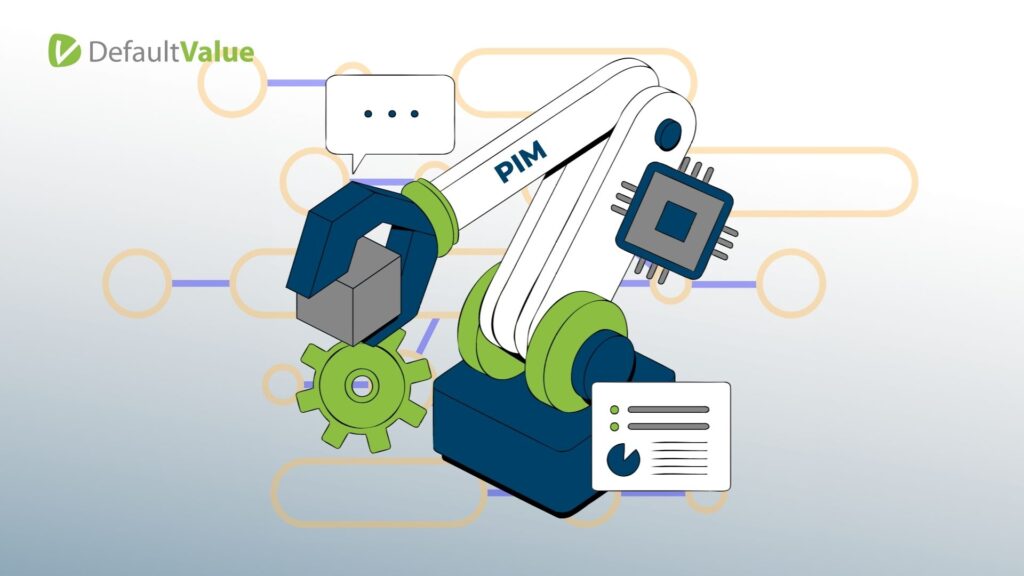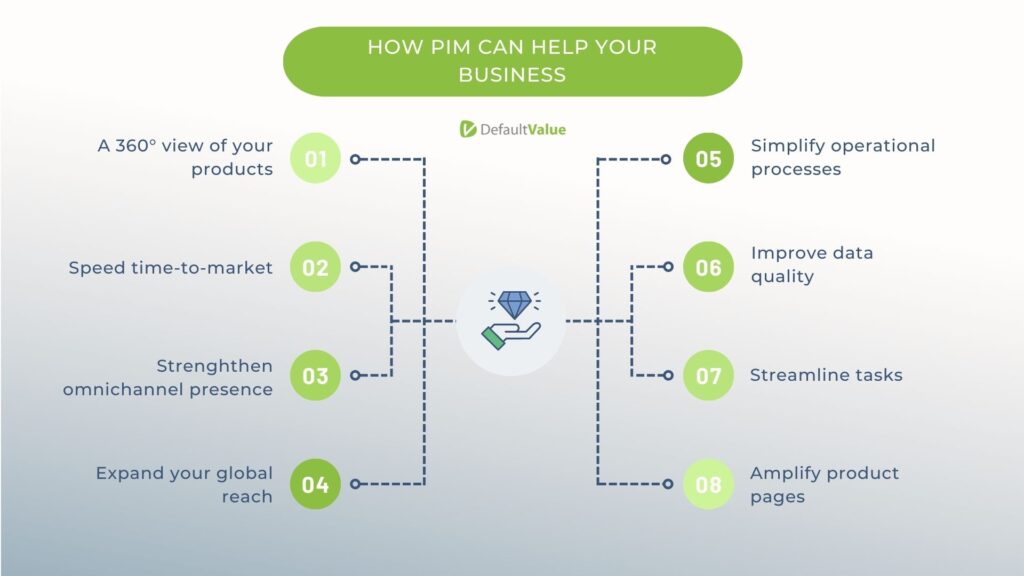PIM Development: Does Your Company Really Need It
In the increasingly digital age, businesses deal with vast product data. This data must be managed efficiently, accurately, and consistently, especially when dealing with multiple sales channels. This is where Product Information Management (PIM) comes into play. It’s a key element in the technology stack of many businesses. It helps to streamline eCommerce operations and provides a centralized platform for managing product data.
The PIM market showcased a remarkable performance in 2019, with a valuation of $9.90 billion. Projections indicate an even more promising future, predicting the market to skyrocket to an astounding $59.25 billion by 2027. This represents an impressive CAGR of 25.2% from 2020 to 2027, underlining the phenomenal growth and potential this sector holds.
The challenge for most businesses lies in keeping product information organized, up-to-date, and readily available across all channels. With the increasing competition in online marketplaces, businesses often struggle with managing product data. This can cause errors and inconsistencies that can negatively impact customer experiences and conversions.
What Do We Know About PIM Development?
Here at Default Value, our experience runs deep in developing robust Product Information Management (PIM) systems. The genesis of this expertise lies in our longstanding relationship with a client-agency serving online stores. Starting with a single module support task seven years ago, our partnership has grown and evolved with our respective businesses.
This collaboration eventually led us to a significant challenge: developing a custom PIM system. The goal was to expedite populating product data in online stores. It’s a traditionally time-consuming task, especially for large-scale operations or businesses managing multiple stores.
After investing 8,000 hours in developing this intricate PIM system, we simplified work for online stores. This case study represents our capability and expertise in PIM development. However, as we discuss in the article, we often encounter clients who request custom PIM development, even when it may not align with their business model. Therefore, we wrote this article to shed light on the specific scenarios where PIM can offer real value and to clarify when it might not be the best fit. As always, we focus on providing the most beneficial solutions to meet our clients’ unique needs.
So let’s dive into the topic of PIM development!
What is Product Information Management?

PIM is a type of software that provides a centralized system to manage all the data needed to sell products. Product information management solutions often include functionalities for catalog management, data integration, data quality, data syndication, workflow management, and more.
The objective of PIM development is to create a single source of truth for product data, ensuring consistency across all touchpoints. This consistency is especially important in eCommerce, where customers expect to see accurate, comprehensive product information. By consolidating product data into a single system, businesses can improve efficiency and provide a better customer experience.
How Does a PIM Strategy Set Up an Organization for Success in 2023?

PIM strategy forms an essential pillar of modern eCommerce operations, especially given the rapid growth of online shopping and the proliferation of digital sales channels. With a robust PIM strategy, businesses can be more efficient and agile, adapting quickly to market changes and customer demands.
In 2023, a successful PIM strategy should incorporate artificial intelligence (AI) and machine learning (ML). These technologies can automate data management processes, improve data quality, and provide valuable insights for decision-making. By using AI and ML, businesses can leverage their PIMs to manage product data and stand out in the marketplace.
PIM vs. MDM vs. DAM: Outlining the Difference
Product Information Management (PIM), Master Data Management (MDM), and Digital Asset Management (DAM) each play vital roles in a comprehensive data management strategy, but they serve distinct purposes and offer different functionalities.
PIM is specifically designed to manage all product-related data. This can range from technical specifications and pricing to product descriptions and images. Its primary purpose is to ensure that product information is consistent, accurate, and up-to-date across all sales and marketing channels. From eCommerce websites and print catalogs to social media platforms and in-store displays.
MDM, on the other hand, takes a broader approach. It governs and integrates all critical data entities within a company, such as product, customer, and vendor data. An MDM system ensures that these data entities are accurate, consistent, and synchronized across the organization’s entire information ecosystem. MDM enables businesses to achieve a single, unified view of their data, which can enhance decision-making, improve operational efficiency, and enable better compliance with regulations.
DAM, in contrast, focuses on managing, organizing, and distributing digital assets like images, videos, and documents. A DAM system typically provides functionalities for cataloging assets, managing metadata, controlling access rights, and tracking usage. DAM solutions are crucial in brand management, content production, and marketing, ensuring digital assets are easily accessible, properly licensed, and used consistently.
While all three systems—PIM, MDM, and DAM—can operate independently, they often work best when integrated into a unified data management strategy. For instance, product images managed in a DAM system can be linked to product records in a PIM system. In turn, PIM can be synchronized with customer records in an MDM system. This interconnected approach can provide businesses with a comprehensive, 360-degree view of their data. It also enables better decision-making, improved customer experience, and greater operational efficiency.
PIM, MDM, and DAM all contribute to effective data management. They each serve unique purposes and are tailored to different types of data and business needs. Understanding their differences can help businesses choose the right solutions for their specific requirements and leverage their data more effectively.
Why isn’t it for Everyone?

While Product Information Management (PIM) is a robust tool capable of streamlining the data management process, it’s important to recognize that it’s not for everyone. Small companies with a limited range of products, single sales channels, or with simple operational demands may not find the intricacies of PIM necessary.
Implementing a PIM system can be arduous, often requiring significant resources, time, and a team of specialists to ensure successful integration. It’s a considerable investment that not all businesses can afford or even need. Furthermore, simpler solutions may exist for these businesses that adequately cover their needs without the complexities and costs that come with PIM.
Additionally, as PIM involves unifying product information across all channels, it is most beneficial for companies operating on a multi-channel or omnichannel level. For businesses that operate through a single sales channel, PIM’s cross-channel data consistency might not be a significant advantage.
Finally, it’s worth mentioning that, like any other system, PIM has its learning curve and maintenance needs. It necessitates training for the staff and continuous updates to adapt to changing business needs and technological advancements. As such, the decision to implement PIM should come after a thorough analysis of the company’s size, needs, resources, and long-term goals.
PIM offers numerous advantages and can dramatically improve data consistency and operational efficiency. Still, its cost, complexity, and maintenance needs may make it less suitable for smaller companies or those with simpler operational demands.
Who Needs Product Information Management?

Let’s consider a company that specializes in selling lychees (Chinese fruits) for many years. This company possesses a profound knowledge of the lychee industry and understands the intricacies and nuances involved. Given this expertise, managing lychee products and their descriptions within a generic PIM system could pose significant challenges due to inherent limitations.
With their extensive industry experience, this company might consider developing a custom PIM solution that caters to its specific requirements. However, it’s important to note that not all companies should necessarily pursue this path. Custom PIM development is not a universally applicable solution and its suitability largely depends on the nature of the business, the complexity of its products, and the breadth of its operations. For instance, if this company also sells various types of fruits beyond lychees without diving deep into the specifics of each product, a custom PIM system might not be the most suitable option. Generally, the narrower a company’s specialization, the more suitable it becomes for custom PIM development. Therefore, companies should carefully evaluate their needs, challenges, and available resources before committing to a custom PIM solution.
PIM proves most advantageous for medium to large businesses that possess a wide range of products, operate through multiple sales channels, and have complex operational requirements. Industries such as retail, manufacturing, and distribution are particularly well-suited for PIM adoption. Businesses that handle intricate product information, maintain extensive supply chains or have a global presence are ideal candidates for PIM implementation. Such companies stand to gain substantial benefits by utilizing PIM to ensure the accuracy and consistency of their product data. In today’s digital landscape, where omnichannel retailing is the norm, providing customers with reliable and consistent product information is crucial for enhancing satisfaction and fostering long-term customer loyalty.
Moreover, businesses that frequently launch new products or update existing ones can significantly benefit from PIM. It can efficiently handle large amounts of data, making the process of adding, updating, and managing product information significantly easier and less prone to errors. Businesses dealing with complex product data structures and regulatory compliance can also leverage PIM’s powerful capabilities.
In summary, any organization that wishes to excel in eCommerce product information management, whether B2B or B2C, could consider implementing a PIM solution. Its ability to centralize data, maintain accuracy, and ensure consistency across all sales and marketing channels makes it an essential tool for modern businesses.
Benefits of Custom Product Information Management Solutions
Custom PIM solutions offer several distinct advantages. They can be tailored to fit a business’s specific needs and workflows, offering more seamless integration with existing systems and processes. This is particularly useful for companies with unique or complex product data management requirements, where off-the-shelf product information management solutions may not be sufficient.
| Unified Product Data | PIM centralizes product data, ensuring consistent and accurate information across all channels. |
| Time and Cost Savings | By automating product data management, PIM reduces manual labor, saving time and reducing costs. |
| Increased Sales | Accurate and comprehensive product information enhances customer experience, leading to increased conversions and sales. |
| Improved SEO | PIM solutions help optimize product data for search engines, increasing visibility and driving more traffic to your site. |
| Enhanced Cross-Selling and Up-Selling | PIM allows for better product association, enabling effective cross-selling and up-selling strategies. |
| Faster Time-to-Market | With streamlined data management, PIM helps get products to market quicker, giving you a competitive edge. |
| Easier International Expansion | PIM simplifies managing and localizing product data for different regions and languages, aiding international expansion. |
| Better Supplier Collaboration | PIM facilitates efficient data exchange with suppliers, improving collaboration and efficiency. |
| Effective Multichannel Management | PIM ensures consistent product information across all channels, enabling successful multichannel strategies. |
| Improved Compliance | PIM aids in managing regulatory information, ensuring compliance with industry standards and regulations. |
Furthermore, custom product information management custom software provides more control and flexibility. Businesses can prioritize the features that matter most to them, ensuring they get the most value from their investment. While custom PIM solutions may require a larger initial investment, they can deliver substantial long-term benefits by improving operational efficiency, reducing errors, and providing a better customer experience.
Use Cases of PIM by Large Companies

Many large companies have successfully leveraged PIM to manage their product data and drive business growth. For instance, IKEA, the multinational home furnishings retailer, discovered many product information management benefits. The company uses PIM to manage its vast product range across multiple countries and languages. PIM helps IKEA maintain product data consistency across its global operations, improving customer experience and enhancing operational efficiency.
Similarly, Unilever, a leading global FMCG company, utilizes PIM to manage its diverse range of products. The PIM system helps Unilever ensure its product data is accurate, up-to-date, and consistent across all sales channels.
Conclusions
While PIM might not be the right solution for every business, it’s an invaluable tool for companies dealing with complex product data and multiple sales channels. It is especially beneficial for businesses aiming to streamline their operations and improve their eCommerce product information management.
As for implementation, the right partner can make all the difference. With our deep expertise in PIM development and eCommerce solutions, Default Value can help businesses leverage PIM to its full potential. From understanding your unique needs to delivering a custom PIM solution that fits your business like a glove, we can guide you through every step of the journey.
By optimizing your product data management with a custom PIM, you can drive growth, improve customer experience, and gain a competitive edge in the challenging world of eCommerce. Remember, PIM is more than just a tool; it’s a strategic investment in your business’s future.




